Top 30 Backyard Birds
Part I Part II Part III Part IV Part V Part VI
|
|
Our previous chapter took a stab at naming the top five most common backyard birds in our area. Chapter Two also features five birds, but this month’s unifying theme is a little more nebulous: these are not the next five most common birds, although none are uncommon. They have some shared characteristics. In size, all are members of a slightly larger class of birds than the house finches and goldfinches that often dominate feeders (and hence our attention). As far as feeders go, in fact, four of these birds don’t eat seed and will not be visitors to your standard seed feeders. Finally, all five of these birds (or at least their near relatives) are particularly prominent in human culture: jay, robin, and oriole are all well-known names. Sometimes, however, it seems that they are becoming less well-known as birds. On an individual level, now is your opportunity to remedy that gap in knowledge.
6. Northern Mockingbird
 Identifying: Mockingbirds are a common bird in most residential neighborhoods. Size-wise, they are in the same general neighborhood as jays and robins. Their basic appearance is a fairly plain gray above and white underneath (see picture above), but bright white patches in their wings and outer tail feathers are revealed when they take flight (see picture to left). Their big claim to fame, as their name indicates, is their song, composed of long series of varied phrases, each repeated 2–6 times (hear an example). These phrases include both imitations of other birds and manmade sounds (car alarms are a common motif). At the height of spring, we tend to hear some complaints about the unpaired male’s habit of singing vigorously throughout the night. We can only suggest the repeated declamation of the following passage as a verbal shield against any nascent ill-will towards the species:
Identifying: Mockingbirds are a common bird in most residential neighborhoods. Size-wise, they are in the same general neighborhood as jays and robins. Their basic appearance is a fairly plain gray above and white underneath (see picture above), but bright white patches in their wings and outer tail feathers are revealed when they take flight (see picture to left). Their big claim to fame, as their name indicates, is their song, composed of long series of varied phrases, each repeated 2–6 times (hear an example). These phrases include both imitations of other birds and manmade sounds (car alarms are a common motif). At the height of spring, we tend to hear some complaints about the unpaired male’s habit of singing vigorously throughout the night. We can only suggest the repeated declamation of the following passage as a verbal shield against any nascent ill-will towards the species:
The Mocking Bird, like the Nightingale, is destitute of brilliant plumage; but…He listens with silent attention to each passing sound, treasures up lessons from everything vocal, and is capable of imitating with exactness, both in measure and accent, the notes of all the feathered race. And however wild and discordant the tones and calls may be, he contrives, with an Orphean talent peculiarly his own, to infuse into them that sweetness of expression and harmonious modulation which characterize this inimitable and wonderful composer.
– Thomas Nuttall, 1903 ornithologist
Attracting: Mockingbirds rarely visit feeders, but will occasionally be drawn to mealworms, raisins, or other less expected fare. Far more often they stick to insects and fresh berries-on-the-tree. They will, however, happily visit birdbaths.
7. American Robin
|
|
Identifying: Robins are a familiar bird across the United States. Although often portrayed as a bird of spring (more or less erroneously), they are present here all year round, and we often seem to have more in winter, when large flocks can be seen congregating on lawns, in berry-bearing trees, or at birdbaths. In summer, many remain here to breed locally, but others head north or to the mountains. You may well recognize them already: roughly jay-sized, though usually appearing rather plumper, robins have dark slate-gray backs, rusty reddish breasts, and yellow bills.
Attracting: Like mockingbirds, robins are not seed eaters, instead eating berries and insects (they are also known for pulling earthworms from damp lawns). Also like mockingbirds, they will occasionally be drawn to mealworm or fruit feeders, but are far more likely to visit birdbaths.
8. Steller's Jay
|
|
Identifying: Our “other jay.” Easily distinguished from scrub-jays (and everyone else) by their brilliant black crest and beautiful rich glossy blue feathers. People are often slightly confused about the range and habitat of this bird: many associate Steller’s Jays with visits to redwood forests and state park picnic grounds where they eye your lunch with an unbecoming interest. But they can also be seen in our broadleaf evergreen forests dominated by live oak and bay and in the narrower wooded corridors that border creeks. In suburban neighborhoods, open woodland, or shrubby habitats, expect scrub-jays. If it’s moist and shady, look for Steller’s. Of course, our well-forested creeksides often merge quickly into more open oak woodland, so there are plenty of opportunities for overlapping edges.
Attracting: Steller’s Jays are a bird that requires a specific type of nearby habitat, as described above. But if you’re in the right place, they are like their omnivorous scrub-cousins and are not hard to attract: sunflower is good, suet is good, Bark Butter is good, and peanuts are adored.
9. Western Bluebird
Identifying: Our most common birds that are "blue" are jays, specifically the Western Scrub-Jay covered in Chapter 1—a relative of the familiarly named eastern "Blue Jay". But “bluebirds” aren’t jays and jays aren’t bluebirds. Unlike jays, Western Bluebirds are mild-mannered, quiet, non-carnivorous (when it comes to birds), and less common in yards. Smaller than jays, they can also be identified by their chestnut-red breasts—females are similar to the male shown below but duller, with more grayish heads. While you almost certainly have seen jays, you may not have seen bluebirds: they can only be found in relatively open areas, such as our oak woodland and savannas with scattered trees, or around places like irrigated athletic fields, both of which can provide the insects they eat.
Attracting: First, you must have the appropriate habitat. Many neighborhoods, filled in with trees, do not. If you do see bluebirds near your home, however, your best bet is putting up a nesting box (= “bird house”) in time for nesting season, which starts as early as February. Birdbaths and mealworms are also attractive–see this year's Bird of the Month page for a mealworm-eating video and more.
|
Western Bluebird by Christine Hansen. Western Scrub-Jay by Risa George. |
10. Hooded Oriole
Identifying: In summer, we get a lot of questions about orioles, most commonly, “what is that big gorgeous bird on my hummingbird feeder?” and sometimes the incredulous “we don’t have orioles here, do we?” Well, we do! Males are magnificent golden, tropical looking birds with black throats and wings. Females look somewhat like giant goldfinches with longer beaks. Orioles nest here in the summer and then head back to Mexico around the end of August. To host breeding Hooded Orioles, you must have a nearby fan palm, in which they exclusively build their nests (they were not present this far north before human planting of palms). Following the completion of nesting, however, it is not uncommon to see them pass through one’s yard as they wander around before their southward journey. Read more about their story in their recent Bird of the Month profile.
Attracting: Hooded Orioles come regular to hummingbird feeders offering sugar water, as long as the feeding ports are large enough to admit their beaks (better sized, oriole-favoring feeders are also available). They also enjoy grape and blackberry jellies and mealworms, particularly when feeding young. Orange slices are frequently cited as good oriole food, but they seem to be far more attractive to the eastern Baltimore Orioles than to our local species.
|
Male to left; female and young to right. Photos by Susie Kelly. |
|


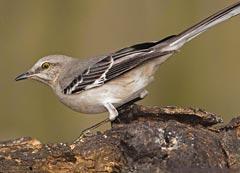
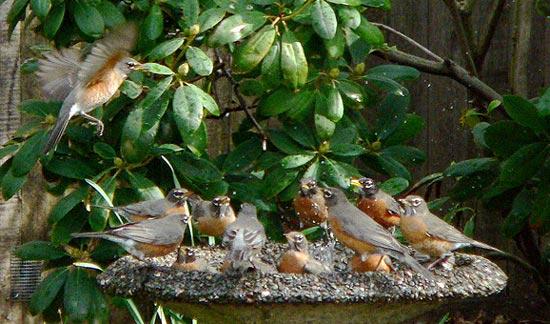
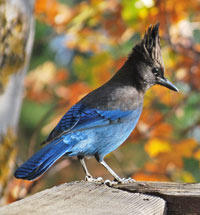
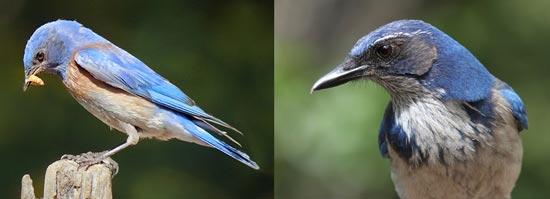

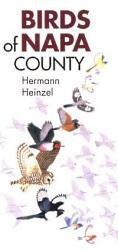 Featured Book: Birds of Napa County
Featured Book: Birds of Napa County